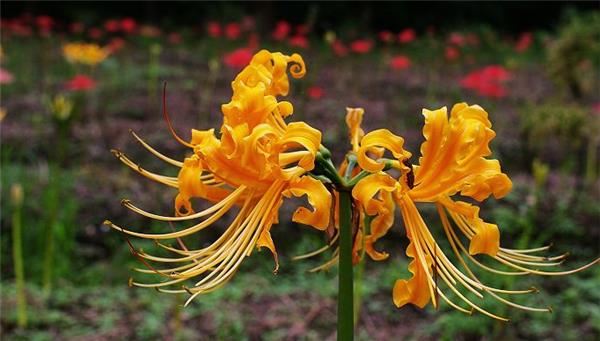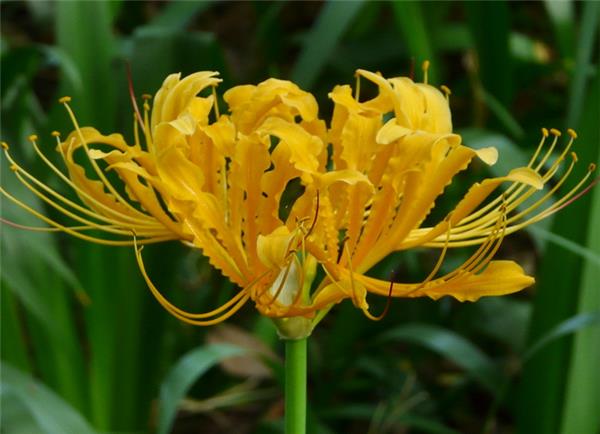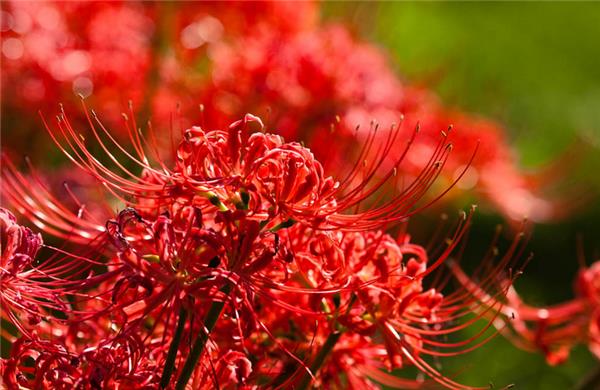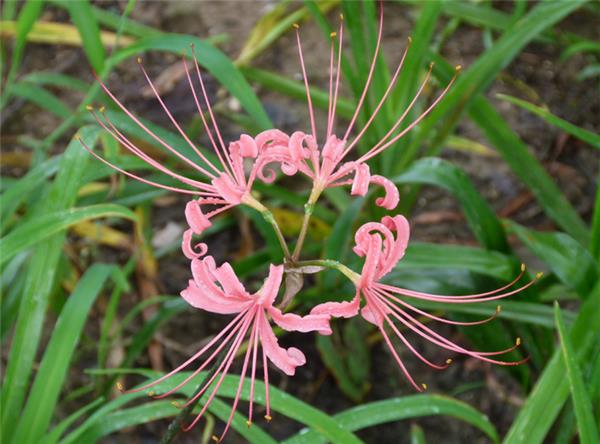Introduction and breeding skills of Huan Jian laughing all over Sichuan in Autumn
"Crab claw silk flap competition winding, colorful hydrangea rhyme is rare. Keep silent all day long, and Huan Jian smiles all over the river in autumn. " Suddenly laughing is a very strange plant with beautiful flowers and leaves: its originally luxuriant green leaves wither without a sound and disappear without a trace in early summer; in midsummer, its flower stems suddenly rise from the ground, blooming unique and golden flowers, giving people pleasure and surprise, hence its name. Let's have a look together.

First, the introduction of a sudden smile
Suddenly laugh, also known as Iron Arrow (Compendium of Materia Medica), Lycoris radiata, is a plant of the genus Lycoris of Lycoris.
Second, the morphological characteristics of sudden laughter.
Perennial herbs. Bulb ovate, ca. 5 cm in diam. The leaves are basal, thick, broad-striped, leafy in autumn, sword-shaped, about 60 cm long, 2.5 cm wide, attenuate to the base, 1.7 cm wide, tip acuminate, with obvious light band in the middle. Flower stem about 60 cm high; involucral bracts 2, lanceolate, about 3.5 cm long and 0.8 cm wide; umbels with 4-8 flowers; flowers yellow or orange; perianth lobes abaxially with light green middle ribs, oblanceolate, ca. 6 cm long, about 1 cm wide, intensity reversing and wrinkling, perianth tube 1.2-1.5 cm long; stamens extending slightly outside perianth, about 16 cm longer than perianth, filaments yellow Style rose-red distally. Capsule trigonous, loculicidal; seeds few, subglobose, ca. 0.7 cm in diam., black, capsule with several seeds per locule. The florescence is from August to September and the fruiting period is October.

Perennial herbs. The bulb is broadly elliptic. Leaves come out in early winter, linear or banded. Flowering stem first leaves drawn, ca. 30cm high, terminal 4 × 6 flowers; flowers bright red or white margin, perianth tube extremely short, distally 6-lobed, lobes narrowly lanceolate, long 4cm, margin wrinkled, revolute outward; stamens 6; ovary inferior, 3-loculed, style slender. Capsule dorsally cleft. There are many seeds. The flowering period is from September to October and the fruiting period is from October to November. Born in damp mountains or jungles, it is also cultivated. The stem is 6 cm tall and consists of 20 layers of persistent petiole sheaths with brown outer bark. Autumn leaves, but also in summer and autumn flowers, leaves come out at the same time. Leaves 4 Mel 8, sword-shaped, green, leathery, 50 mi 60 cm long and 2 mi 3.5 cm wide, attenuate to base and folded in half, apex acuminate, midrib flat above, dorsal and elevated. The flower stem is 60 Mel 80 mm high, some up to 100 cm, green, sometimes purplish, 5 Mel 15 mm thick. Involucral bracts 2, lanceolate, membranous, white, 3 mm long, 1 mi 1.5 mm wide, apex acuminate, reflexed when blooming; umbels with 9 flowers, 1 bracteole per flower, bracteoles white, linear-lanceolate, 0.5 mm long and 1 mm wide; pedicels green, trigonous, 1 mm long; perianth 7 cm long; perianth tube long) cm Perianth lobes 6, yellow, 2 whorls inconspicuous, equal, banded, gathered above, revolute upward, 5ml 6m long, 5Mel 10mm wide, keel-shaped abaxially in middle rib, apex beaked, margin thin on both sides, with 3LV 6 pairs of wrinkles; stamens 6, gathered below, filaments yellow, base connate with perianth tube, separated to throat, 6m long, 7cm long, sometimes up to 10 cm, protruding, then curved. Anthers purple-brown, linear, 10 mm long, ca. 1.2 mm wide, dorsally T-shaped, 2-loculed, lateral dehiscence, contracted and recurved into horseshoe-shaped after dehiscence; style linear, yellow, distal purple, 9 Mel 10 m long; ovary green, subglobose, 34 mm long. Capsule trigonous, loculicidally dehiscent; seeds few, black, subglobose, 6 mm in diam., surface finely tuberculate. The florescence is from May to August and the fruiting period is November. Bulb ovoid, 2 mi 3 cm in diam., bark brown. Leaves come out in autumn. The leaves are banded, more than 40 cm long and 1.5 mi wide. Involucral bracts 2, lanceolate. Umbels have 8 flowers, pedicel 3.5 Mel 4 cm long; perianth symmetrical, about 7.5 cm long; red, perianth tube to 1.5 cm long, lobes oblanceolate, 6 cm long, 1.2 cm wide, apex obtuse; stamens gathered below, apex curved, filaments 6.5 cm long, nearly as long as perianth; style 8 cm long.

Third, the ecological habit of sudden laughter.
Born on wet rocks or under stony cliffs where the soil is fertile. Negative plants, like warm and humid environment, but also slightly resistant to cold, have summer dormancy habits, do not choose soil, but with humus-rich, moist and well-drained soil is appropriate. Like a warm and humid environment, born on wet rocks or under stony cliffs where the soil is fertile. The cold tolerance is slightly poor, and the aboveground parts often wither due to frost injury in the middle and lower reaches of the Yangtze River in winter, but the underground bulbs can survive the winter safely. It has the habit of dormancy in summer, flowering from August to September.

Suddenly laugh can also be like daffodils for hydroponic viewing, do not have some fun. The method is that after June every year, when the leaves on the laughing ground fall off completely, dig the bulb out of the soil and keep the root intact as far as possible, soak the root in 25 ℃-30 ℃ warm water with a little potassium permanganate for 24-36 hours, then plant it in a daffodil pot or other utensils and fix it with broken stones, and place it in an indoor ventilated and well lit place. Beautiful flowers can bloom in 10 days and 15 days. During the flowering period, except for the timely addition of water, there is generally no need to apply fertilization. when the flowers fade, the bulbs can be cut off and re-implanted into the soil for maintenance until the coming year. Daily management suddenly cold-resistant, early-resistant, saline-alkali resistance, fear of waterlogging and sun exposure, too strong light is the main factors leading to its non-flowering. Daily management should pay attention to keep the soil moist, especially before flowering, in case of dry weather, it is necessary to continuously irrigate for 2-3 times. During its growing period, some thin and quick-acting chemical fertilizers can be applied as appropriate, and when the flower stem gradually begins to draw out, it can be combined with watering and apply a thin, mature phosphorus and potassium fertilizer. When approaching the dormant period, you should gradually reduce watering and stop fertilizing.
The above is the knowledge of sudden laughter. I hope I can help you.
When the leaves on the laughing ground fall off completely, dig out the bulbs from the soil and try to keep the roots intact. Soak the roots in 25 ℃-30 ℃ warm water with a little potassium permanganate for 24-36 hours, then plant them in daffodil pots or other utensils and fix them with broken stones. Put them in a well-ventilated and well-lit place indoors. Generally, beautiful flowers can bloom in 10 to 15 days. During their flowering period, in addition to adding water in time. Generally, there is no need to apply fertilizer. when the flowers fade, the bulbs can be cut off and the bulbs can be re-implanted into the soil for maintenance until next year. Daily management suddenly cold-resistant, early-resistant, saline-alkali resistance, fear of waterlogging and sun exposure, too strong light is the main factors leading to its non-flowering. Daily management should pay attention to keep the soil moist, especially before flowering, in case of dry weather, it is necessary to continuously irrigate for 2-3 times. During its growing period, some thin and quick-acting chemical fertilizers can be applied as appropriate, and when the flower stem gradually begins to draw out, it can be combined with watering and apply a thin, mature phosphorus and potassium fertilizer. When approaching the dormant period, you should gradually reduce watering and stop fertilizing.
The above is the knowledge of sudden laughter. I hope I can help you.
Related
- Wuhan Hospital Iron Tree Blooming Result Was Instantly Frightened by the Gardener Master
- Which variety of camellia is the most fragrant and best? Which one do you like best?
- What is the small blue coat, the breeding methods and matters needing attention of the succulent plant
- Dormancy time and maintenance management of succulent plants during dormancy
- Minas succulent how to raise, Minas succulent plant pictures
- What are the varieties of winter succulent plants
- How to raise succulent plants in twelve rolls? let's take a look at some experience of breeding twelve rolls.
- Attention should be paid to water control for succulent plants during dormant period (winter and summer)
- Watering experience of twelve rolls of succulent plants
- Techniques for fertilizing succulent plants. An article will let you know how to fertilize succulent plants.



